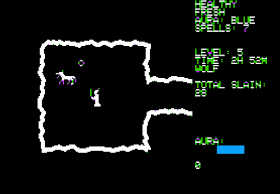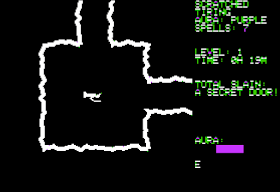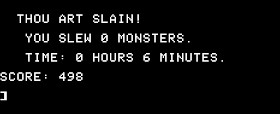Sorcerer of Siva
United States
Automated Simulations/Epyx (developer and publisher)
Released in 1981 for Apple II and TRS-80
Date Started: 7 April 2019
Date Ended: 7 April 2019
Total Hours: 7
Difficulty: Hard (4/5)
Final Rating: 11
Ranking at Time of Posting: 12/327 (4%)
Sorcerer of Siva was supposed to be a quick detour--a kind of coda to my recent coverage of Keys of Acheron. I was so sure I'd finish it within a couple of hours that I originally planned to slot this entry, which I thought would be short, as a "bonus" between two regular ones. The game ended up taking most of an entire Sunday, and when I was done my desk was covered with scribbles and maps. "This was not the MicroQuest I was promised!" I wanted to scream.
But therein lay the problem: Epyx never said that
Siva was a "MicroQuest," the label it used for two early
Dunjonquest spinoffs:
Morloc's Tower (1979) and
The Datestones of Ryn (1979). When
I played them in 2013,
Morloc's Tower took less than an hour, and
Ryn was time-limited by design to 20 minutes.
Siva is within that tradition--a standalone title with a fixed character, limited RPG mechanics, a short duration, no ability to save, and a final score that encourages replay. But it's much longer and much harder than its predecessors, such that it pushes the boundaries of decency when it comes to its lack of a save capability.
 |
In a typical Sorcerer of Siva screen, I'm standing in the center of a room with a wolf nearby. A bit of treasure (a ring) is waiting for me after I defeat him. This game is unique in the Dunjonquest series in that different types of treasure have different icons.
|
The two 1979 titles, featuring a hero named Brian Hammerhand, was at least given attributes and items (although since they were unchangeable, they were constants, not variables), but the magic-using hero of Siva doesn't even have a name. What he does have, for the first and only time in the Dunjonquest series, are spells: "Open," "Heal," "Fireball," "Reveal Distance to Stairway," "Jump," "Bolt of Lightning," and "Teleport," each mapped to a different key (usually the first letter). The player starts with a number of spells from 0 to 7 depending on the chosen difficulty level. Actually casting the spells depletes an "aura" bar that recharges slowly. Spells can be forgotten but remembered (or discovered for the first time) by finding "touchstones" throughout the dungeon. You find them in a fixed order, so if you have only one spell, it's always "Open"; if you have two, it's always "Open" and "Heal"; and so on through the list above and ending with "Teleport."
The other commands, including "L," "R," and "V" to move and turn, using the number keys to move forward a number of steps, "A" for attack, and so forth remain the same as previous Dunjonquest entries. "Y" has you drink a healing elixir if you've found any; "E" examines the wall for secret doors; "S" searches for traps.
The setup is that the character is stuck in the Mines of Siva, pursued by the minions of the infamous Sorcerer of Siva, and must escape. Escape is on the fifth level of the mines, and the character must find the exit within 4 game hours or the door will shut for the night, and "nothing human can survive a night in the Mines of Siva." Along the way, you pick up treasures and kill monsters to increase your final score, and you can even kill the Sorcerer himself. The game begins on Level 1 of 5. The large dungeon has more than 300
rooms, and of course you don't try to explore them all each game. You can
even get sent below Level 1, to a shifting "Underworld" full of
monsters, where you have to struggle to escape to the regular difficulty
of the Mines.
The game invites you to set both a skill level and a "speed factor" at the beginning of the session, encouraging you to play for the first time on Level 1, which starts you with 7 spell slots and always starts you in the same location. Higher skill levels randomize your starting location and lower the number of starting spells. The speed factor adjusts the real-time length of a turn, and thus the speed at which the clock counts down. Functionally, a high speed factor means that you end up "passing" a lot of turns unless you're prepared to act quickly. The ultimate challenge is to win the game at skill level 8 and speed factor 10.
 |
| The only options before beginning the game. |
It's pretty hard even on Level 1. A turn lasts about 6 seconds, and there are 5 turns per game minute, meaning you have about 2 hours to escape the dungeon. Monsters appear relentlessly as you stand around--vampire bats, demons, giant spiders, ghouls, goblins, skeletons, trolls, and elementals among them--and blasting them with your spells drains your aura quite fast. Even worse is the fatigue meter, which goes from "Fresh" to "Exhausted" (at which point you can't do anything) in the space of about a room and a half. Attempting to stand still and rest to restore both meters tends to just encourage more monsters to appear. It's very easy to get into a cycle of exhaustion that you can't get out of.
The dungeon is huge, each level containing a maze of 64 rooms in an 8 x 8 configuration (except Level 2, which for some reason uses 16 x 4). Although there are theoretically multiple staircases upwards, they tend to be clustered in one part of the dungeon. Finding one could take hours; in my first attempt, I was on Level 1 for 2.5 game hours (about 1.25 real hours). If you don't start with all the spells, touchstones are extremely rare. You could easily make it to Level 5 without finding more than two or three. A decent portion of valid paths are blocked by secret doors, which take multiple rounds to identify and may take multiple castings of "Open" to allow passage. Monsters tend to spawn while you're searching.
 |
| The south wall has a secret door. It will take multiple castings of "Open" to open it. |
You can fight monsters with your dagger in melee range, but that's a last resort. Injuries make spell and fatigue restoration last much longer, and it's easy to get into a inescapable downward spiral if your health drops too low. "Bolt of Lightning" usually kills monsters in one hit; "Fireball" does the same for some of the lesser monsters.
 |
| I blast a "Fireball" at an ogre. |
The worst part of the game is the existence of trap doors, which spawn randomly in corridors. You can often only avoid them with the "Jumping" or "Teleportation" spells, or by turning around and finding another path. If you fall into one, you end up in the "Underworld," below Level 1, and you have to find your way back to the place that you started. There's really no point in continuing the game when this happens, since it leaves you in a worse position than when you started.
Another menace is the titular Sorcerer, who can show up in any room on any level. But he's a coward, and he only appears if you're already fighting another monster. He sits in the background and makes you forget spells every round, so that you need to find touchstones to remember them. Because he always pops up behind the monsters you're fighting, you can't target him directly--and he's only vulnerable to "Bolt of Lightning" in any case.
My plans for a quick game thus collapsed when I found myself unable to progress without cheating with save states, and even then I was unable to get out of the dungeon in the time limit on my first try. Resisting the temptation to abandon it completely for a Star Control II session, I girded myself with soda and Cape Cod chips, warned Irene she wouldn't be seeing me for a while, and settled in for a long period of testing and mapping.
 |
| The box quite notably says "MicroQuest" nowhere. |
A few strategies came to light, most of which Redhighlander had already discovered. You almost never want to just walk through a room. That leaves you vulnerable to monsters appearing in front of you and trap doors. The "Teleportation" spell, which moves you one room in the direction you're facing, is a godsend. It takes almost all of your spell points, but sometimes casting it and replenishing is faster than walking through a room, fighting a combat or two on the way, and having to wait for your fatigue to replenish anyway. If you're unable to teleport a particular direction, you know you're at the edge of the map.
"Locating a Staircase" is also helpful, but it only tells you the distance, not the direction. You basically have to triangulate with it. "Jump" can get you through a room in two castings and is thus often as useful as "Teleportation."
Monsters chase you to the edges of rooms but they never leave their rooms. And when you leave and re-enter, they're always in the center. So if you need to rest up, you can straddle the door between two rooms, resting for a couple of rounds in each one and exiting just as the monster approaches you. Another strategy is to find a room where a secret door blocks you from the room's center. Since enemies only spawn in the center, these are free rest places.
As for the sorcerer, I found a decent strategy for dealing with him. You have to be on guard, but the moment he appears, you have to hit "9" to run past the monster you're fighting so there's nothing in between you and the sorcerer. Then you can blast him with "Bolt of Lightning." He usually managed to drain one of my spells ("Teleportation" is always the first to go) even when this worked, but it's worth it because once the sorcerer is dead, most of the high-level enemies like demons and efreet stop appearing.
 |
| Here's a shot of me killing the sorcerer. It looks like the zombie is in between us, but I think I jumped past him and the screen just hasn't refreshed yet. |
Most important to my success, however, was my map. The dungeon has a fixed layout, including the position of secret doors. Treasure locations are randomized, but staircases remain in the same position. I didn't map the entirety of every level, but I mapped enough to find the way to the up staircases on each level.
 |
My mostly-completed map of Level 4. The alternating shaded/non-shaded areas are the game's "rooms."
|
With these strategies and resources, I was able to get a new character out of the dungeon in a little over 3 hours on Level 1.
 |
| My best attempt. |
Higher levels mean starting with fewer spells. At Level 2, you don't have "Teleportation" until you find a touchstone. At Level 4, you don't have "Jumping" and thus have to walk everywhere. (You functionally cannot outrun creatures unless you enter the room with no fatigue. Even then, you might find that you're unable to move the last two or three steps to the exit while the creature closes in on you.) At Level 8, you have no spells whatsoever. I can't see beating the game at Level 5 or above unless you're extremely lucky with the positioning of touchstones and trap doors. I tried it a few times, but I kept getting killed by enemies quickly or tossed down to the Underworld.
 |
| I accomplished nothing and still got 498 points. |
I should also mention that I played the game at 250% emulator speed. Playing at era-accurate speeds redefines "excruciating." I wouldn't give it to someone on death row.
Sorcerer of Siva isn't really an RPG by my definitions, lacking any character development, inventory, or stats-based combat. It thus performs pretty miserably on the GIMLET, earning only 11 points (2 points each for game world, magic and combat, interface, quests, and gameplay, plus one for encounters). This is the lowest total yet for a Dunjonquest game; I just gave Acheron a 24 two days ago. But if nothing else, it shows how the same engine can be used for extremely different types of games. This one wasn't for me.











I would rather have spells than a name, anyway.
ReplyDeleteYou made me laugh this morning, thank you!
DeleteSo glad you’re playing these! I found all of them quite challenging back in 1979, but then again was 10 years old and didn't have any experience with CRPGs. The limitations of a cassette-based TRS-80 forced the developers to be quit creative, and they met the challenge well.
ReplyDeleteOh man, this game! I beat Apshai and Hellfire Warrior no problem, could win Morloc's Tower in 30min, I could even free 7/10 prisoners in Rescue at Rigel, but Sorcerer of Siva just stumped me.
ReplyDeleteThanks for playing this one and confirming that it really was that hard. I got it for a present, and was super excited to play it. I imagined spell battles, running from wolves, racing through a cave system, looking for a way out, etc., but was totally disappointed by the actual game. Obviously, it was a huge bummer. I still remember it clearly 30+ years later.
Thank YOU for confirming that the game felt very different to a contemporary player.
DeleteThis one felt very much like an arcade game to me more so than any of the others in the Dunjonquest series. I got very luck and had the sorcerer literally appear right on top of one of the monster lackeys so I was able to kill two for the price of one with a lightning bolt. Then it was an excruciating search for the exit on level 5. Very different feel I completely agree. If it were not for the locate stairs spell I'd of ripped my hair out
ReplyDelete